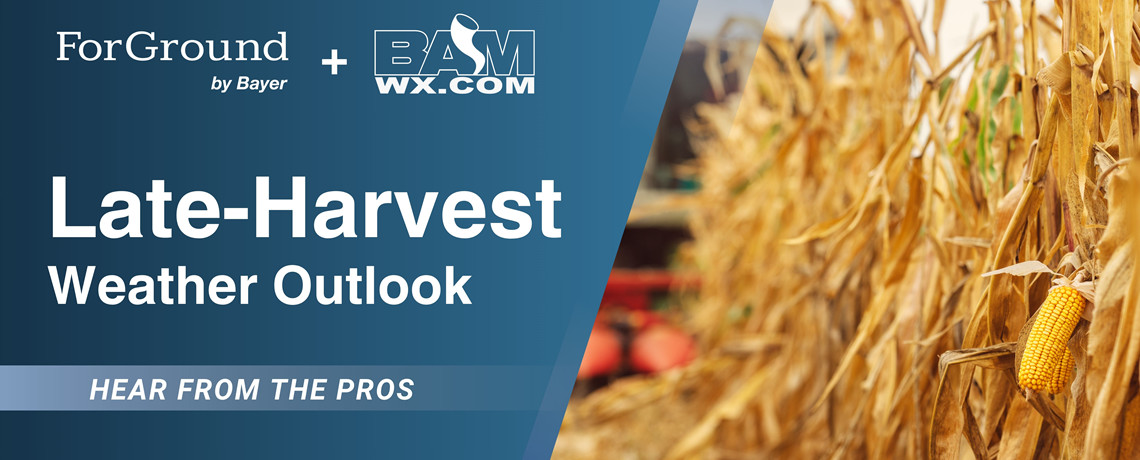
2025 Late-Harvest Weather Outlook
Written by: Andrew Welch, Sustainable Agronomist at ForGround by Bayer, and the experts at BAM Weather
We’ve teamed up with BAM Weather meteorologists to bring you a detailed, region-specific weather report for late-harvest 2025.
Key Insights
- Soil Moisture Concerns: Northern Illinois, Indiana, Ohio, and Michigan are experiencing very low soil moisture percentiles due to inconsistent rainfall, with potential improvements expected in the lower Ohio Valley and northern Plains over the coming months.
- Cold Front Arrival: A cold front is set to arrive around November 4th, bringing colder-than-normal temperatures to the Eastern US, with a frost/freeze risk particularly for the SE US to Mid-Atlantic.
- La Niña Impact: Weak La Niña conditions are expected to persist into early 2026, favoring colder temperatures in the northern US and increased storm activity, while areas like western Texas and southwestern Kansas may experience a drier winter.
Soil Moisture Monitor


Here is a look at the top 3 feet (100 cm) of soil moisture (in terms of percentiles) for this time of year. Lack of consistent rains for N. Illinois, N. Indiana, N. Ohio and Michigan have led to very low soil moisture percentiles persisting throughout October. While the pattern becomes more favorable ahead for above normal moisture, it may take multiple months to make up notable ground. Most likely improvement areas ahead will be the lower OH Valley and parts of the N. Plains.
Medium Range Hazard Map


Another strong cold front will arrive around November 4th and bring colder than normal air to the Eastern US. While not expected to be a powerful or record breaking cold front, it will bring temperatures much below normal for a few days in the SE US to Mid-Atlantic and potentially pose another widespread frost/freeze risk. Areas in the darker blue should especially be monitoring this risk as it pertains to frost/freeze and abnormally low overnight lows for this time of year.
Week’s ¾ Outlook


Mild air will spread eastward during this period leading to more consistent above normal temperatures for the Central to Eastern US. Most above normal temperatures will likely situate in the N. Plains and Upper-Midwest. An active northern stream will likely feature frequent “weak” precipitation events across the northern tier of the US and above normal moisture. Primary storm track and “bigger” storms possible from NE Texas through the Great Lakes/Midwest.
November Outlook


November may see front-end and back-end colder air in the E. US, but warmer than normal air for a few weeks in the middle part of the month will likely drive the overall outcome to run milder than normal for much of the US (especially the SW US and N. Plains/Midwest). La Niña forcing will drive an active northern jet stream and above normal moisture across the N. Plains/Canadian Prairies, Great Lakes and OH Valley.
ENSO Forecast Update


Model Predictions
Recent observations indicate ocean waters in this region at -0.6C indicating we have already reached La Niña territory. Latest model guidance highlighted above indicates weak La Niña conditions should persist into December - January - February. The upcoming mild mid-November pattern closely resembles weak La Niña years. Into December, this does overall favor colder than normal risks for the northern tier of the US (especially for the N. Plains and Upper-Midwest), though this ENSO state can increase variability in January. Generally, this set up favors a colder northern tier of the US vs. normal and warmer risks in the southern US.
December Outlook


Along with weak La Niña years leaning colder overall in December, signals for a weaker than normal polar vortex and tropical forcing both tend to support a colder start to winter. As a result, we have trended our December outlook colder in recent weeks for the East Coast (especially the NE US) with much below normal temperatures favored for parts of the Midwest. An active storm track is also favored especially for the Ohio Valley meaning above normal winter storm threats for the Midwest, Great Lakes, OH Valley and interior northeast US in December.
Winter DJF Outlook (December - January - February)


Diving further into the storm track signal for winter, a consistent feature during La Niña winters over the past ~2 decades is much below normal precipitation for W. Texas, W. Oklahoma and SW Kansas. Confidence is higher than normal that these areas see a relatively dry winter. Some split flow of the jet streams will mean parts of the Central Plains and Midwest that have lower than normal soil moisture may struggle to adequately replenish this winter. More consistent moisture opportunities vs. normal likely for the NW Plains, Mountain West and Ohio Valley.
About the Report:
This report isn't just a forecast; it's a helpful tool to make informed decisions for your farm. As a member of ForGround by Bayer, you'll get a weather forecast just like this delivered straight to your inbox every month. Plus, no matter where you are on your regenerative agriculture journey, with ForGround, you will gain year-round access to science-based agronomic support, insights, and discounts, and will be the first to know when new potential revenue streams arise.
Did you know? ForGround members can now claim an exclusive 20% discount on a BAM Weather Clarity Starter or Clarity Pro subscription for one year. Learn more